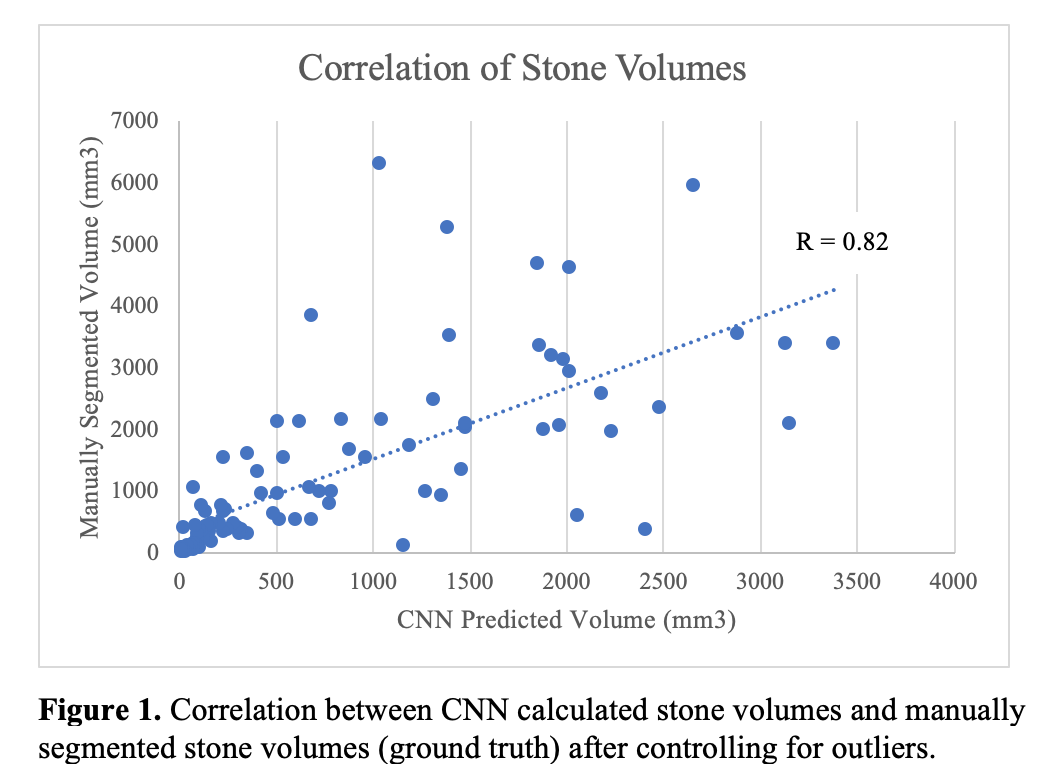Back
Poster, Podium & Video Sessions
Moderated Poster
MP33: Uroradiology I
MP33-02: Automated Stone Volume Determination: Training an Artificially Intelligent Algorithm to Segment Kidney Stones on CT and Calculate 3D Volume
Saturday, May 14, 2022
4:30 PM – 5:45 PM
Location: Room 228
Kalon L. Morgan*, Rohit Bhatt, Sina Soltanzadeh Zarandi, Kelvin Vo, Minh-Chau Vu, Paul Piedras, Akhil Peta, Andrew Brevik, Rajiv Karani, Lillian Xie, Pengbo Jiang, Sohrab Ali, Roshan M. Patel, Jaime Landman, Ralph V. Clayman, Orange, CA

Kalon Ln Morgan
University of California, Irvine
Poster Presenter(s)
Introduction: The majority of kidney stone literature uses two-dimensional linear measurements on imaging to estimate stone burden. Linear-based formulas such as the European Association of Urology (EAU) ellipsoid formula fail to account for three-dimensional variations in shape when estimating stone volume. With modern software, manual segmentation of stones on CT scan allows for more precise volume estimations; however, it is work intensive in its current form. We sought to employ a deep learning convolutional neural network (CNN) to automatically segment and calculate stone volume on CT imaging.
Methods: 771 renal stones from 119 unique patients were identified on low-dose, non-contrast CT scans. Volumes for each stone were calculated via manual segmentation. A 20 layer fully-convolutional contracting-expanding CNN spanning 473,410 parameters was designed to detect, segment, and calculate renal stone volume using the manual segmentations as ground truth. The algorithm accomplished this by searching a 48 × 48 × 48 voxel cube in the vicinity of a user-placed seed point. Both a Pearson correlation coefficient and Dice score, a metric of spatial overlap, were used to assess CNN performance against manual segmentations. Volumes for each stone were also calculated using the EAU ellipsoid formula, and compared to manually segmented volumes. Statistics were aggregated after five-fold cross-validation of the data set. Also, each CNN-derived stone segmentation was further multiplied by the stone mask and visualized with a color scheme providing a Hounsfield Unit (HU) heat map that demonstrated radiolucency changes throughout each stone.
Results: The CNN-calculated stone volumes when compared to manually segmented volumes had a Dice score of 0.56 and a Pearson correlation coefficient (r-value) of 0.82. The EAU ellipsoid formula when compared to manually segmented volumes had a Pearson correlation coefficient (r-value) of 0.75.
Conclusions: The UCI deep learning algorithm can automatically segment renal stones and produce stone volumes that correlate better with manual 3D volume segmentations than the EAU ellipsoid formula.
Source of Funding: None

Methods: 771 renal stones from 119 unique patients were identified on low-dose, non-contrast CT scans. Volumes for each stone were calculated via manual segmentation. A 20 layer fully-convolutional contracting-expanding CNN spanning 473,410 parameters was designed to detect, segment, and calculate renal stone volume using the manual segmentations as ground truth. The algorithm accomplished this by searching a 48 × 48 × 48 voxel cube in the vicinity of a user-placed seed point. Both a Pearson correlation coefficient and Dice score, a metric of spatial overlap, were used to assess CNN performance against manual segmentations. Volumes for each stone were also calculated using the EAU ellipsoid formula, and compared to manually segmented volumes. Statistics were aggregated after five-fold cross-validation of the data set. Also, each CNN-derived stone segmentation was further multiplied by the stone mask and visualized with a color scheme providing a Hounsfield Unit (HU) heat map that demonstrated radiolucency changes throughout each stone.
Results: The CNN-calculated stone volumes when compared to manually segmented volumes had a Dice score of 0.56 and a Pearson correlation coefficient (r-value) of 0.82. The EAU ellipsoid formula when compared to manually segmented volumes had a Pearson correlation coefficient (r-value) of 0.75.
Conclusions: The UCI deep learning algorithm can automatically segment renal stones and produce stone volumes that correlate better with manual 3D volume segmentations than the EAU ellipsoid formula.
Source of Funding: None


.jpg)
.jpg)